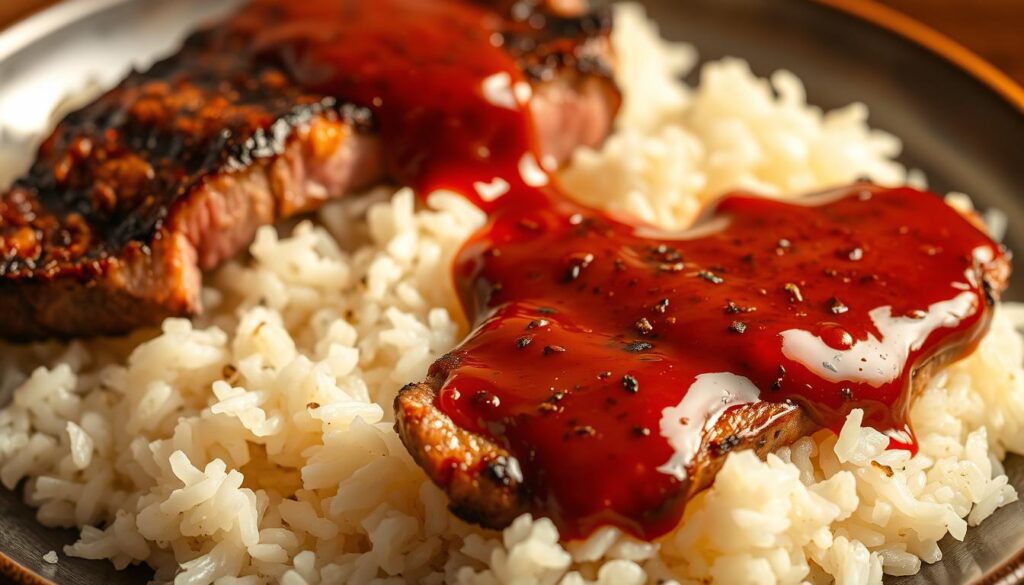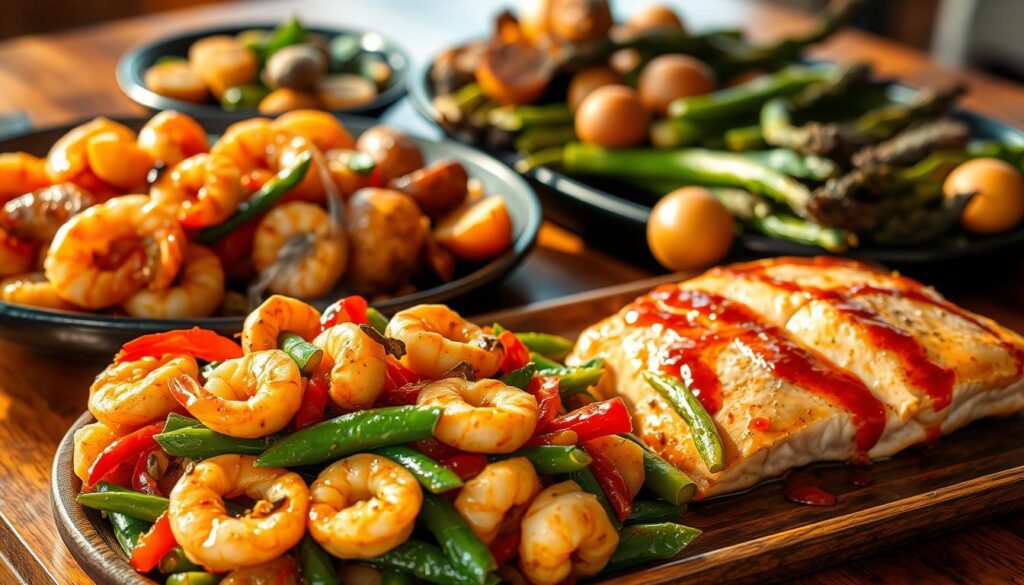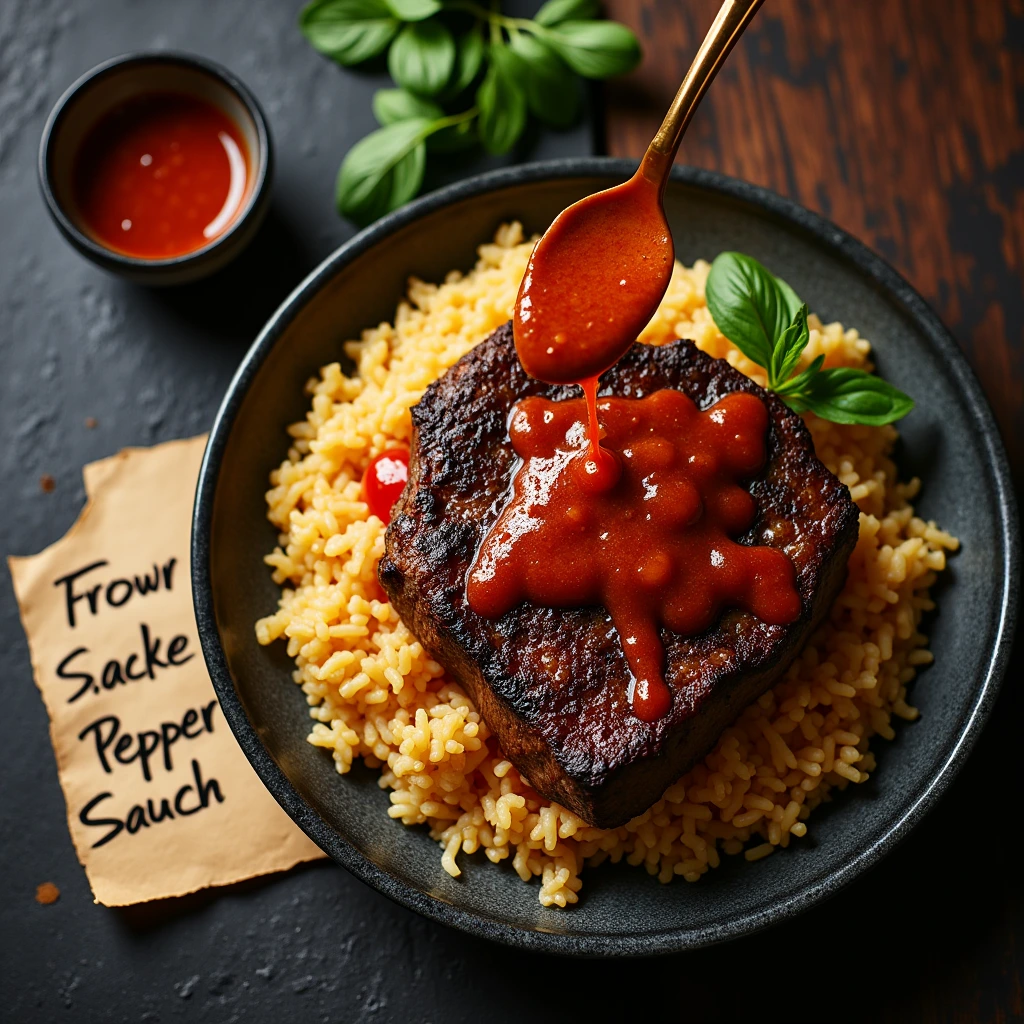Table of Contents
Imagine you’re at your kitchen counter, cooking meat and veggies. Then, that amazing tangy-sweet smell hits you. That’s the magic of pepper lunch sauce. It turns simple steak and rice into a dish everyone loves.
For years, this sauce from Japan has been a hit in restaurants. But now, you can make it at home too. It’s all about that bold flavor.
Learning how to make pepper lunch sauce is more than just following a recipe. It’s about making meals as good as those in Tokyo. This guide shows you how to mix soy sauce, sugar, and chili oil just right. Plus, it gives tips to avoid mistakes.
Key Takeaways
- Master the pepper lunch sauce recipe to replicate restaurant flavors at home.
- Discover how this sauce transforms basic ingredients into craveable steak pepper rice.
- Learn about the sauce’s origins and its rise in global food culture.
- Get practical advice for ingredient substitutions and storage.
- Preview step-by-step instructions and pro cooking tips inside.
What Is Pepper Lunch Sauce and Why It’s So Popular
Pepper lunch sauce is more than just a condiment. It’s a big deal in the world of food. It started in Japan and quickly became famous. The popular pepper lunch sauce is known for its mix of soy sauce, chili oil, and garlic.
This mix is loved by many. It’s found in places like New York and Los Angeles. It’s a big hit worldwide.
Origins of the Pepper Lunch Restaurant Chain
The chain started in the 1980s. It introduced the “sizzling plate” idea. Customers see chefs making their meals right in front of them.
They add hot sauce over rice and steak. This show makes the authentic pepper lunch sauce a big deal.
Why This Sauce Has a Cult Following
- Flavor Balance: It’s sweet, salty, and spicy, making it hard to stop eating.
- Customization: You can use it on sushi, as a marinade, or in ramen.
- Nostalgia: It’s a comfort food for many, reminding them of their childhood.
Restaurant vs. Homemade Differences
| Aspect | Restaurant Sauce | Homemade Sauce |
|---|---|---|
| Ingredients | Secret recipes with premium imported spices | Adjustable spice levels using common pantry items |
| Preparation | Pre-made in bulk using industrial equipment | Batch cooking at home with a skillet |
| Consistency | Thicker due to gelatin-based thickeners | Thinner unless arrowroot powder is added |
Restaurant sauces are consistent, but homemade ones let you adjust flavors. Both aim to bring out that special umami taste.
The Perfect Flavor Profile of Authentic Pepper Lunch Sauce
The best pepper lunch sauce has four main flavors: sweet, savory, umami, and peppery. Each flavor is important for the delicious pepper lunch sauce’s unique taste. Sweetness comes from caramelized onions or brown sugar, balancing the salty soy sauce and fish sauce. Cracked black pepper adds heat without being too much.
| Flavor | Source | Role |
|---|---|---|
| Sweet | Caramelized onions, brown sugar | Softens heat and balances saltiness |
| Savory | Soy sauce, oyster sauce | Forms the base’s richness |
| Umami | Tomato paste, mushrooms | Enhances meaty depth |
| Peppery | Cracked black pepper, white pepper | Provides aromatic heat |
When cooking, sugars caramelize, making the sauce sweeter. Peppery notes soften as the sauce cooks, letting umami stand out. This change makes every spoonful of steak rice full of flavor.
Missing one flavor messes up the balance. Too much pepper, and it’s too spicy. Too little soy, and it’s bland. To make the delicious pepper lunch sauce at home, you need to balance all flavors well.
Heat helps change simple ingredients into something complex. Your goal is to let each flavor be heard, not to let one overpower the others.
Essential Ingredients for Making Pepper Lunch Sauce at Home
Learning about the pepper lunch sauce ingredients is crucial for making the authentic pepper lunch sauce. These elements combine to give the sauce its unique savory and slightly spicy flavor.
Must-Have Base Ingredients
These ingredients are essential for the sauce’s base:
- Soy sauce: It adds a deep umami flavor. Choose Kikkoman for the best results.
- Garlic and ginger: Use grated forms to release their full aroma and heat.
- butter: It balances the sauce’s saltiness with creamy richness.
- Black pepper: Freshly ground black pepper gives the sauce its signature heat.
- Sugar: Light brown sugar adds a caramelized note.

Optional Flavor Enhancers
Add these to enhance your sauce:
- Mirin or rice vinegar for a bright taste
- Sesame oil for a nutty flavor
- Minced scallions for a fresh garnish
Ingredient Substitutions for Dietary Restrictions
Make adjustments for different diets:
- Soy-free: Use coconut aminos (less salty, adjust sugar)
- Gluten-free: Tamari soy sauce (make sure it’s certified gluten-free)
- Vegan: Plant-based butter (be mindful of melting point)
Substitutions might change the sauce’s texture a bit. But they should keep the core taste the same.
Step-by-Step Recipe for Delicious Pepper Lunch Sauce
Want to make Pepper Lunch Sauce at home? This guide makes it easy. It’s perfect for beginners or experienced cooks. Follow these steps to make the famous dish served with steak rice.
Preparation Time and Cooking Equipment
Start with 10 minutes of prep and 25 minutes of cooking. You’ll need a medium saucepan, whisk, and a heatproof bowl. A meat thermometer helps with even cooking. If you don’t have a whisk, a regular spoon works too.
Mixing and Cooking Instructions
- Heat 2 tbsp oil in the saucepan over medium heat. Add minced garlic and ginger; sauté until fragrant.
- Stir in soy sauce, brown sugar, and red pepper flakes. Cook until sugar dissolves completely.
- Simmer uncovered for 15–20 minutes, stirring constantly. The sauce thickens when ready.
- Blend or strain the mixture for a smoother texture if preferred.
Pro tip: Adjust spice levels by tweaking pepper flakes. Taste frequently to balance sweetness and heat.
Storage and Shelf Life Tips
- Transfer cooled sauce to airtight glass jars or containers.
- Refrigerate for up to 2 weeks or freeze in ice cube trays for 3 months.
- Discard if mold appears or the aroma turns sour.
Reheat frozen cubes in a saucepan with a splash of water. Always store in opaque containers to preserve flavor.
Creating the Perfect Spicy Pepper Lunch Sauce Variation
To make a spicy pepper lunch sauce that excites, start with a solid base. Traditional recipes use a mix of chili peppers. But, you can make it your own with these tips:
- Chili choices: Thai bird’s eye chilies or Serrano peppers bring sharp heat. Smoked paprika or gochugaru add deeper flavors.
- Heat levels: For mild, add 1 tsp dried flakes. For medium, use 2 tsp plus a dash of sambal oelek. For fiery, mix 3 tsp + ½ tsp harissa paste.
- Balance technique: To balance heat, add ½ tsp brown sugar or extra soy sauce. This adds depth to your delicious pepper lunch sauce.
If your sauce is too hot, add coconut cream or broth to cool it down. Let it sit for 10 minutes to blend flavors. Try adding fresh ginger or black vinegar for more layers of heat. Always test small amounts of spice and adjust salt to keep the sauce complex. This way, your sauce will be vibrant and balanced, whether you like a little warmth or a big kick.
How to Pair Your Homemade Pepper Lunch Sauce with Steak Rice
Getting the flavors and textures right makes your homemade pepper lunch sauce a complete meal. Follow these steps for a dish that rivals restaurant quality.

The Ideal Rice Preparation Technique
Choose jasmine or Thai fragrant rice for its fluffy texture. Rinse it twice to remove starch. Cook with a 1:1.25 water ratio—1 cup rice to 1.25 cups water.
Fluff the rice with a fork after cooking. This ensures it’s separate before serving.
Steak Selection and Cooking Method
Go for skirt or flank steak for tenderness. Marinate slices in soy sauce and sesame oil for 15 minutes. Cook in a hot cast-iron skillet for 2-3 minutes per side.
Let the meat rest for 5 minutes before slicing. This makes it juicy. Serve with a drizzle of your best pepper lunch sauce.
Vegetable Additions That Complement the Sauce
- Traditional picks: Bean sprouts for crunch, snap peas for freshness, and carrots for sweetness.
- Modern twists: Roasted mushrooms or asparagus add earthiness. Julienned cucumber slices lighten the dish.
- Pro tip: Add vegetables during the last 2 minutes of steak cooking to retain crispness.
Where to Buy Pepper Lunch Sauce When You’re Short on Time
If you can’t make pepper lunch sauce from scratch, finding ready-made options is easier than you think. Here’s how to track down this popular condiment quickly:
Online Retailers That Ship Nationwide
Order buy pepper lunch sauce directly from these platforms:
- Amazon: Search “Pepper Lunch Sauce” for verified sellers offering fast shipping.
- JAPAN Mart: Ships direct from Japan with no minimum orders.
- SushiSushi: Includes it in their Asian grocery bundles for US delivery.
Asian Grocery Stores in the US That Carry It
Visit these chains’ international food aisles:
- Mitsuwa Marketplace: Check their sauces section near soy sauce and ramen.
- 99 Ranch Market: Ask staff in the ready-made sauces aisle.
- H Mart: Look for it near Japanese curry blocks and instant noodles.
Price Comparison and Best Deals
Prices vary by retailer. Online options typically cost $5–$8 per bottle, while store-bought jars range $6–$10. Save money by:
- Purchasing bulk sets from Amazon bundles.
- Buying during store sales (e.g., Mitsuwa’s quarterly Asian food discounts).
- Opting for 16-ounce jars instead of single-serve packets.
Compare prices seasonally—winter sales often offer lower rates on imported pepper lunch sauce.
Common Mistakes to Avoid When Making Pepper Lunch Sauce
Mastering the pepper lunch sauce recipe needs careful attention. Steer clear of these common mistakes to get it right. Even small errors can mess up the flavor of your how to make pepper lunch sauce. Here’s how to catch and fix these mistakes before they ruin your dish.
- Overloading on soy sauce: Too much soy can overpower other tastes. Use only 2 tablespoons for the right umami.
- Burning garlic: Charred garlic tastes bitter. Cook it gently until it’s translucent, not brown.
- Ignoring spice ratios: Too much chili powder can make it too hot. Add spices slowly and taste as you go.
- Skipping tomato paste: This adds depth. Add 1–2 tablespoons for real richness.
- Rushing simmering time: Cooking it too short makes it too thin. Simmer until it coats a spoon.
Check the sauce’s smell and feel often. If it’s too salty, add a teaspoon of sugar. For too much water, simmer uncovered to reduce it. Making these adjustments as you go keeps your pepper lunch sauce recipe on track.
Other Delicious Dishes That Benefit From Pepper Lunch Sauce

Want to try something new with your authentic pepper lunch sauce? It’s great for more than just steak rice. Try these ideas to make the most of your homemade sauce.
Seafood Applications
- Coat shrimp or scallops in cornstarch before sautéing and toss with reduced-sugar pepper lunch sauce for a sweet-and-savory stir-fry.
- Brush salmon or cod fillets with the sauce during the last 5 minutes of baking to create a caramelized glaze.
- Simmer mussels in the sauce with garlic and ginger for a quick, aromatic broth.
Vegetarian and Vegan Options
Make the pepper lunch sauce ingredients vegan by swapping oyster sauce for soy sauce or mushroom broth. Here are some ideas:
- Pan-fried tofu cubes coated in the sauce and roasted vegetables like bok choy or mushrooms.
- Marinate seitan in the sauce overnight for a meaty stir-fry dish.
- Drizzle over roasted eggplant or zucchini slices for a savory twist.
Fusion Cuisine Ideas
Turn the sauce into a global pantry staple:
- Mix into Western-style pasta dishes or as a pizza topping with mozzarella.
- Use as a base for a Thai-inspired curry by blending with coconut milk and lemongrass.
- Whisk into scrambled eggs or drizzle over avocado toast for a bold breakfast.
Conclusion: Elevate Your Home Cooking with Perfect Pepper Lunch Sauce
Making your own pepper lunch sauce brings restaurant-quality flavor home. This guide showed how to balance spices like soy sauce and chili oil. You can follow the classic recipe or try new variations.
Every batch lets you control the heat and ingredients. The steps to avoid common mistakes ensure your sauce tastes rich and savory. This is what diners crave.
Pepper lunch sauce isn’t just for steak rice. Use it as a marinade, dipping sauce, or stir-fry base. If time is tight, online stores and local Asian markets offer shortcuts. But homemade versions let you adjust flavors precisely.
Pairing tips from earlier sections help match the sauce to proteins, veggies, or even vegetarian dishes. This proves its versatility.
Mastering this sauce gives you a versatile tool for weeknight meals or dinner parties. Share your creations on social media or with neighbors. This way, you can join home cooks perfecting this dish.
Every adjustment—whether swapping ingredients for dietary needs or tweaking spice levels—keeps the tradition alive. It makes it your own. The satisfaction of serving a homemade version that rivals restaurant flavors is within reach. Start cooking and discover how this one sauce can transform your everyday meals into standout dishes.
FAQ
What is Pepper Lunch sauce?
Pepper Lunch sauce is a tasty Japanese condiment. It has a mix of sweet, savory, umami, and peppery flavors. It’s famous for adding depth to dishes like steak pepper rice at Pepper Lunch restaurants.
Where can I buy Pepper Lunch sauce?
You can find Pepper Lunch sauce online or at Asian grocery stores. Many places offer shipping across the country for your convenience.
How can I make homemade Pepper Lunch sauce?
Making homemade Pepper Lunch sauce is easy. You’ll need soy sauce, garlic, ginger, and butter. Follow a recipe to get the authentic taste of the restaurant.
What are the best ingredients for Pepper Lunch sauce?
The key ingredients are soy sauce, garlic, ginger, and seasonings. You can also add sesame oil or mirin for extra flavor.
Can I make a spicy variation of Pepper Lunch sauce?
Yes, you can make a spicy version. Add chili peppers, chili paste, or sriracha. Adjust the heat to your liking.
How long does homemade Pepper Lunch sauce last?
Homemade sauce lasts about a week in the fridge. Store it in an airtight container. You can freeze it for longer, thawing it before use.
What common mistakes should I avoid when making Pepper Lunch sauce?
To avoid mistakes, measure ingredients carefully and control the heat. Don’t overcook garlic to prevent bitterness.
What dishes can be enhanced with Pepper Lunch sauce?
Pepper Lunch sauce is great for more than steak and rice. It’s good with seafood, tofu, and even grilled meats or fried rice.

